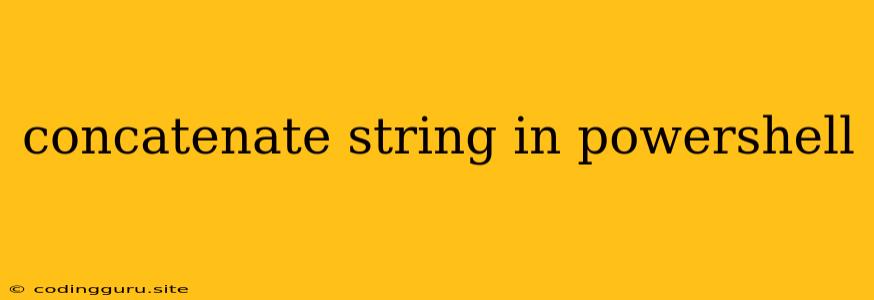Concatenate String in PowerShell: A Comprehensive Guide
PowerShell is a powerful scripting language that allows you to automate tasks and manage systems efficiently. One of the fundamental tasks in scripting is working with strings, and concatenating strings is a common requirement. In this guide, we'll explore various methods to concatenate strings in PowerShell, providing you with a comprehensive understanding of this essential technique.
Why Concatenate Strings?
Before diving into the methods, let's understand why string concatenation is important:
- Creating Dynamic Messages: You might need to dynamically create error messages or informational messages based on variables or user input.
- Building File Paths: Combining strings allows you to construct file paths for accessing files and folders.
- Combining Data: You can join data from different sources, like variables, user input, and file contents, into a single string for further processing.
Methods for String Concatenation
Let's examine the most common methods for string concatenation in PowerShell:
1. Using the + Operator:
The most intuitive method for concatenating strings is using the + operator, similar to other programming languages.
$firstName = "John"
$lastName = "Doe"
$fullName = $firstName + " " + $lastName
Write-Host $fullName
This code snippet combines $firstName and $lastName with a space in between, producing the output: John Doe.
2. Using the -join Operator:
The -join operator provides a more efficient and flexible way to concatenate strings, especially when dealing with arrays.
$names = "Alice", "Bob", "Charlie"
$combinedNames = $names -join ","
Write-Host $combinedNames
This example uses the -join operator with a comma separator to join elements of the $names array, resulting in: Alice,Bob,Charlie.
3. Using String Formatting:
PowerShell supports various formatting options for creating dynamic strings, including:
a. Format Operator (-f):
$age = 25
$message = "You are {0} years old." -f $age
Write-Host $message
The -f operator allows you to insert variables into a string using placeholders {0}. This output displays: You are 25 years old.
b. String Interpolation ($()):
$city = "New York"
$greeting = "Welcome to $city!"
Write-Host $greeting
String interpolation lets you embed variables directly into strings using ${}. This results in: Welcome to New York!
4. Using the += Operator:
Similar to other languages, the += operator can be used to append a string to an existing string variable.
$message = "Hello"
$message += " World!"
Write-Host $message
This example appends " World!" to the original string "Hello," resulting in: Hello World!
Tips and Considerations
- Type Conversion: Be mindful of data types when concatenating strings. If you try to concatenate a string with a non-string value, PowerShell will automatically convert the non-string value to a string before concatenating.
- String Literals: If you need to include special characters like double quotes (
") within your string, use a backtick (\). For example,$message = "This is a string with a \" quote."will properly handle the double quote.
Examples and Use Cases
Let's look at some practical examples of how string concatenation is used in PowerShell:
-
Generating Report Files: Imagine you need to create a report file containing system information. You can use string concatenation to build the file name, combine data from different sources, and write the report to a file.
-
Creating Custom Messages: You can use string concatenation to create dynamic error messages or notifications. For instance, when a script encounters an error, you can create a message that includes the error description and the script's name.
-
Building PowerShell Commands: Concatenation is useful for constructing complex PowerShell commands dynamically. This allows you to customize the command based on variables or user input.
Conclusion
Mastering string concatenation in PowerShell is essential for efficient scripting. This guide has provided you with a comprehensive overview of the various methods, their advantages, and practical examples. By understanding these techniques, you can effectively manipulate and combine strings to create dynamic scripts and streamline your PowerShell automation tasks.
